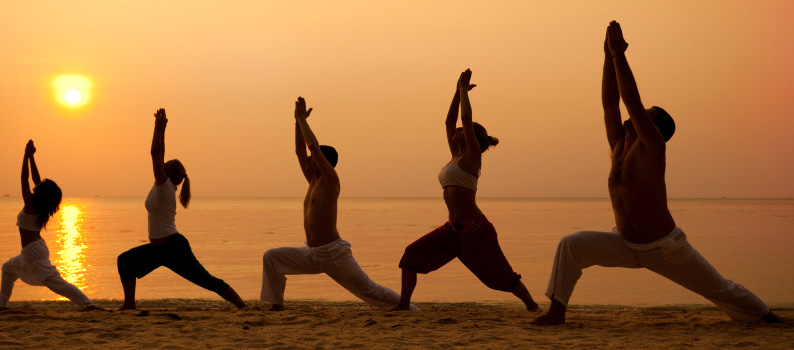Fundamentals of Yoga

Man is the known as the highest creation of God. Among all types of living species, he alone has the power to control his thoughts, actions and feelings using the power of this mind. Yoga is an ancient practise from India, which teaches man the art of transcending to an even higher level of consciousness, where his sense of the ‘self’ is obliterated and he becomes one with the Almighty God through his actions and thoughts.
Reaching that level of consciousness is not an easy task, considering that yogi’s in India dedicate their whole life to attain Moksha. However there are some basic fundamental approaches which everyone can follow to experience more peace and harmony in their lives.
- The basic fundamentals of Yoga is based on the concept that human beings are basically spiritual beings and aims to free us from the shackles of this worldly bondage that ties us down to our mundane existence of wants, wishes and desires. Yoga aims to make us realise our inner divinity which is much beyond our body mind and possession.
- In order to attain this superior level of consciousness, it is important that as individuals we lead a moral life that is guided by the principals of law, order, truthfulness, virtue, chastity, compassion and kindness. It is only when we follow these basic guidelines that we can realise our true nature fully.
- Yoga is a mind and body practise, which means one, has to exercise both the mind and the body to reap the benefits. Firstly we need to practise the yogic poses correctly every day, which would keep our body fit. Secondly we need to engage in daily meditations so that we can understand of our minds and discover our true consciousness.
- Yoga is all about breaking the shackles of regularity, which binds us to a pattern of life. In order to become a perfect yogi an individual needs to replace undesirable habit patterns with positive ones. As part of the Yogic philosophy a yogi needs to let go all types of attachment, which alone holds the key to our liberation.
- The masters or gurus who teach yoga to his disciples are regarded as channels of benevolent energies, or blessings. The process by which a guru blesses a disciple is called “transmission” (samcâra) in section schools of Jaina yoga and Buddhist Yoga.
- Yoga is basically initiatory in nature and one needs guidance from a qualified teacher to attain success in this line. The higher one proceeds in the level of consciousness, the more shall he feel the need for a proper guru.
- Keeping in mind the different types of mental and physical disposition of different individuals the early practitioners of yoga classified this ancient branch of learning into seven broad categories.
- Hatha Yoga- Developed during the 12th century, the practises of Hatha Yoga, involves the use of some amount of force in practising various asana. Hatha Yoga is widely practised in the western countries and is one of the most popular forms of yogic practises followed by people all around the world.
- Jnana Yoga- This form of yoga is all about the liberation of the mind and attainment of wisdom through yogic practises.
- Raja Yoga- This is traditionally regarded as “classical yoga” and aims to teach the yogi the principals of gaining control over mind and emotions.
- Karma Yoga- Widely based on the teachings of Bhagavad Gita, Karma yoga teaches the philosophies of selfless action through which liberation can be achieved.
- Bhakti-Yoga- Bhakti yoga teaches the principals through which one can achieve state of spiritual enlightenment or liberation through the realisation of oneness with God.
- Tantra Yoga – Tantra Yoga is a form of yoga where two people in conjugation try to attain a common or universal consciousness by practising certain yogic principals and postures. Tantra yoga has nothing to do with sex or man- woman relationship.
- Mantra Yoga- Mantra yoga aims to attain liberation through continuous chanting of powerful words which creates a certain aura of empowerment around the reciter
Yoga is a gradual and slow process by which the conscious self-encompassing our thoughts, ideas and emotions is replaced by an understanding of the higher consciousness which can lead us on the path to true self-realisation.
- Karma Yoga
- Jnana Yoga
- Bhakti Yoga
- Kriya Yoga
- Asanas / Postures
- ARDHACAKRASANA
- BHUJANGASANA
- CHACKRASANA
- DHANURASANA
- View More
- Different forms of Yoga
- Hatha Yoga
- Kundalini Yoga
- Bhakti Yoga
- Karma Yoga
- View More
- Pranayama
- Suryabhedan
- Ujjayi
- Sheetali
- Sheetkari
- View More
- UN Declaration of Yoga Day
- Objectives of World Yoga Day
- Controversy on Yoga day
- Logo of Internation Yoga Day
- Fundamentals of Yoga
- Hand Mudra
- Yoga Day Messages
- Yoga Day SMS
- Yoga Day What's App Messages
- Yoga Day Essay
- Yoga Day Speech
- When is Yoga Day
- Yoga Day Quotes
- Yoga Day Poems
- Benefits of Yoga
- Slogans on Yoga
- Yoga Day Clipart
- Yoga Day Images
- Articles
- A Way Celebrating Your Health
- 10 Extraordinary benefits of Yoga
